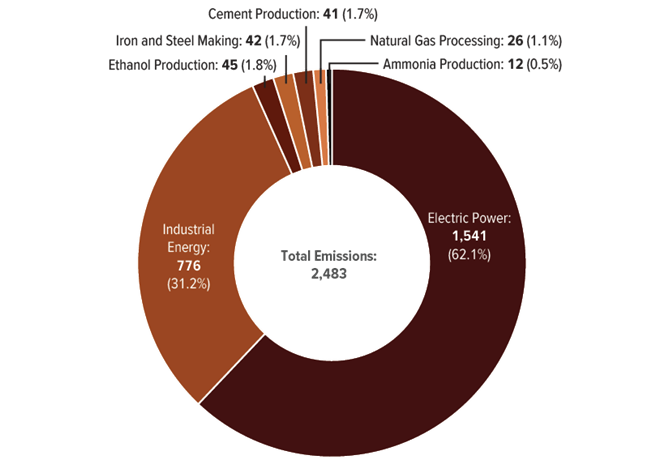Carbon capture and storage (CCS) or carbon sequestration, is a process that captures carbon dioxide (CO2) emissions from sources like coal-fired power plants and either reuses or stores it so it will not enter the atmosphere. Carbon dioxide is then transported through pipelines and stored in geologic formations including oil and gas reservoirs, unmineable coal seams, and deep saline reservoirs and structures that have stored crude oil, natural gas, brine, and CO2 over millions of years.
One way the United States can decrease its GHG emissions to combat climate change is to trap emissions of CO2 and store them permanently underground. Fifteen CCS facilities are currently operating in the United States, which together have the capacity to capture 0.4% of the nation’s total annual CO2 emissions. An additional 121 CCS facilities are under construction or in development. If all of them were completed, they would increase the nation’s CCS capacity to 3% of current annual CO2 emissions. Almost all CCS facilities recoup some of their costs using the captured CO2 to force more oil out of partially depleted oil wells. More recently, the 2021 Infrastructure Investment and Jobs Act (IIJA) provides $8.2 billion in advance appropriations for CCS programs over the 2022–2026 period. In addition, companies that capture and store CO2 are eligible for the Section 45Q federal tax credit, which gives them an incentive to use CCS.
Most industries whose primary output is carbon, such as oil and gas companies, and those that cannot change to newer modes of electrification, cleaner technologies, or update product design or value chain to curb emissions, like ExxonMobil, have effectively combined CCS facilities and biofuels to offset carbon output. Companies in the UK like Global Thermostat and Climeworks lead CCS in infrastructure build and consulting, trapping carbon, transporting it in ocean liners, and storing it deep in offshore storage or repurposing it efficiently.
CCS facilities capture carbon dioxide before it enters the atmosphere. Because CCS removes CO2 where and when the emissions occur, it is referred to as point-source capture of carbon dioxide. Alternatively, CO2 emissions that have already been released into the atmosphere can be removed in a process known as direct air capture (DAC). DAC facilities are more expensive than CCS, a living reality in European nations like Iceland and the UK, which have successfully installed them and are curbing emissions on a large scale.
After it has been captured, CO2 is purified and compressed to produce a concentrated stream of pressurized liquid that can be transported, generally through pipelines, to storage sites. Two ways currently exist for permanently storing carbon dioxide underground: enhanced oil recovery (EOR) and geologic sequestration.
In enhanced oil recovery, CO2 is injected into underground oil reservoirs to dislodge oil that remains after the initial phases of extraction. Some of the injected CO2 returns to the surface with the dislodged oil and is recycled in the EOR process to recover more oil, until almost all the carbon dioxide remains trapped underground.
In geologic sequestration, by contrast, CO2 is injected into porous rock, such as a saline formation, a half mile or more below the surface to ensure that it remains trapped. With either geologic sequestration or EOR, the injected CO2 is sealed permanently underground by a layer of low-permeability rock, known as caprock, that overlays the storage formation.
The United States currently has about 5,200 miles of pipelines that carry carbon dioxide. CCS facilities are typically located near major (“trunk”) pipelines and storage sites to minimize the length of the pipelines needed and to exploit economies of scale in their capacity. Offshore pipeline projects exist in addition to onshore pipelines. And among onshore pipelines, differences in terrain—such as whether the pipeline crosses mountains or large rivers—affect costs. Newer pipelines, along with repurposing existing natural gas pipelines, are being currently explored to widen the network. Most of the storage currently in the US is in the Gulf Coast and South-Central regions of the United States, which contain most of the country’s saline formations.
CO2 Emissions in the United States in 2021 from Sources that Are Potential Candidates for Carbon Capture and Storage (Millions of Metric Tons)

The use of CCS is limited to industrial processes, particularly those in which the cost to capture CO2 is low, such as processing natural gas, producing ammonia for fertilizer, and producing ethanol for vehicle fuel and other uses. Though of limited use today, regulations, cost of infrastructure, storage, and transport can pose interesting challenges and opportunities for CCS in the future and can help the US curb emissions and combat climate change on a larger scale.


